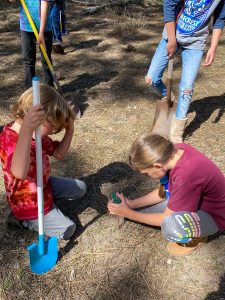The California Department of Food and Agriculture (CDFA) is celebrating Healthy Soils Week from December 5 to December 9. Continue reading to find out what retired CDFA employee and Master Gardener Julie Silva thinks about soil.
Look down. Think about the last time you took off your shoes and squeezed that moist, soft soil between your toes. As you stand on the ground, there are a billion microorganisms living in a single teaspoon of soil under your feet. Those microorganisms are true lifeguards, protecting our lives and the earth. As with many superheroes, soil and its living components are the least understood resources in our landscape.
What do soil and microorganisms do to be held in such high esteem? Soils are a living ecosystem, acting as the “living skin of the planet.” Good soil grows good plants. Soil and microorganisms filter and break down man-made and natural pollutants and provide water, nutrients, and oxygen for plants. Working together, they imbibe and sequester carbon, enriching the soil and lessening atmospheric carbon gas. They hold the soil together to fight erosion, and grab and hold more water.
Now you know there are billions of microbes, worms, pathogens, parasites, root feeders, bacteria, fungi, nematodes, protozoa, arthropods, mites, and more under your toes. They are yours to feed, house, and care for to enjoy their benefits.
Initially, they appear just like the soil—lifeless and not too useful. However, life forms in the soil have particular levels, or trophic levels, in the soil ecosystem. Just as with animals above ground, the food chain describes who eats whom. This Soil Food Web creates a pathway to energy and nutrients for those billion hungry mouths. The bottom of the pile, known as autotrophs or producers, makes its own food. Autotrophs are usually one celled organisms or plants. Autotrophs use photosynthesis to make a delicious combination of sunlight, carbon dioxide, and water to create food (glucose). Those nutrients feed plants that feed animals that in turn die and become food for fungi and bacteria. Decomposers like fungi and bacteria complete the cycle by returning nutrients to the soil. Living plants also provide sugars and compounds to fungi and bacteria in the root area. Just as above ground, the soil and its inhabitants are complex and intertwined.
Before we have nightmares of tiny buggy organisms chomping at the soles of our tennis shoes, we should think about our responsibility to the dirt and its inhabitants. How do we invite these microbes to dinner? What do they want in order to kick-start soil health? Feeding them organic materials (microorganisms, plants, and animals in various stages of decomposition) fits the menu. Top of the grocery list is compost, either homemade or commercial. Four two-cubic foot bags will almost cover 100 square feet of garden area to a depth of one inch. A truckload of three square yards will cover a 1000 square foot area to a depth of one inch. Composts that are manure based have more nutrients. Make your own compost from leaves, pine needles, grass clippings, shredded tree trimmings, and kitchen scraps.
Healthy soil is the most important aspect to gardening. Good soils allow us to recover from planting mistakes. Good soil is like winning the power ball. Healthy soil should be revered and respected. Nature can take up to 500 years to make an inch of soil. The least we should do is feed it and make it stronger.
Julie Silva is a University of California Cooperative Extension Master Gardener of Tuolumne County.

